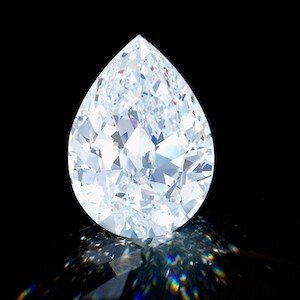What the Crypto are diamond NFTs?
With the recent sale of a 101ct diamond at Sotheby’s being purchased by a Cryptobuyer, we wanted to get our heads around the emerging world of Cryptocurrency and more specifically diamonds being sold as NFTs.
An NFT or non-fungible token, provides digital proof of ownership and thereby receipt of a unique asset. Whilst the token or file, is digital, the assets that the token represents can be both digital and non-digital.
NFTs are built on blockchain, technology that effectively acts as a digital ledger. From mine to consumer, a diamonds form changes from rough to cut, frequently passing through numerous hands and many continents before it gets to the end consumer; therefore, having a digital record of its life story is very helpful. For example, it was recently reported during a meeting of the Kimberley Process, that a number of countries are still using the sale of rough diamonds to fund violence by the ruling authorities, which is still allowed under KP rules, as opposed to the funding of rebel groups, which is not allowed – semantics, but important and not in the spirit of the agreement - therefore, in this instance, surely blockchain technology could offer a better, much more enforceable and transparent solution?
One of the arguments for NFTs is that not only do they embed information within the digital file that acts as property rights, but they also remove the need for ‘middle-men’. However, by removing the middleman, you are also presumably removing pertinent regulations and considerations for what is ‘appropriate’ and ‘transparent’ trading?
“As owners of a fund specialising in fancy-coloured diamonds, our processes are under a huge amount of scrutiny and regulatory processes; and that is fine, that is what we want it to be. Our concern however is that, with all the hype around NFTs there are a number of marketplaces which could, or in some cases already are, selling diamonds and other collectible assets at hugely inflated prices. There appears to be trust in NFTs, but without knowledge of a diamonds worth,” said Mahyar Makhzani, Co-Founder and Joint Managing Director of Amma Group.
As a fund that is required to provide four independent valuations of its diamonds on a quarterly basis, we wanted to understand how a diamond NFTs initial value is established therefore, we decided to look more closely at Opensea, and their NFT platform for diamonds.
Established in 2017, Opensea is a peer-to-peer marketplace for NFTs. In 2020, Opensea launched Icecap, an NFT platform for diamonds. With a stellar leadership team combining extensive knowledge across the diamond and cryptocurrency sectors, this very much looks like a platform that can be trusted, but we wanted to use our in-depth knowledge of diamonds to put their theory to the test.
Icecap has what they call a Value Index, currently in BETA, which guides the seller to a suggested price based on an average wholesale price plus a 1.5 multiplier, to create a theoretical (and presumably realistic) “investor price level.” Icecap then compares the asking price on every diamond listed, to the suggested investor price at that moment in time, to establish which diamond NFTs are selling below or above the proposed value.
This all sounds good and as realistic and transparent as can be, but to be sure we checked the stones listed on Icecap against the prices listed on Rapnet, a B2B Online Diamond Market, present in 100 countries, with over 1 million diamonds listed at a value of $7.1b. As a B2B tool, diamonds are valued at wholesale price on Rapnet. Our findings showed that all stones on Icecap are listed at less than the suggested 1.50 multiple, which is great, until you learn that most stones on Rapnet are currently traded at around 50% below ‘Rap’, therefore making the stones on Icecap, very expensive.
Like with most things there are lots of additional considerations when buying and selling via a ‘new’ platform. Below are a few things we discovered on Icecap:
1. Sellers listing a stone as an NFT, are allowed to include royalty fees, in other words, every time their stone is re-sold, they are allowed to take a percentage of the sale, up to a maximum of 10%.
2. Whilst there are GIA certificates, there are no condition reports, that you would have access to, should you buy via an auction house for example.
3. There is a 1% trading fee for all NFTs on Icecap.
4. There is a fee for taking physical possession of the stone.
5. There is an annual storage fee, if you do not redeem the stone.
6. Should you redeem the stone, there are shipping and insurance considerations.
7. Sales tax will apply, should you take possession of the stone.
“We are certainly not saying that NFTs do not have a place in the diamond world – it’s not our place to say that, but what we are saying is that not everything is always as it may seem and if you are looking to invest in diamonds, there is a lot more than meets the eye. It might be described as akin to buying a beautiful old property, without having the relevant searches done, only to find out later that you overpaid, there’s hole in the roof and you don’t own the freehold” added Philip Baldwin, Co-founder and Joint Managing Director, Amma Group.
In theory, NFTs certainly look like an interesting proposition, but in reality, everybody has to make money and therefore it is not surprising to see that prices are higher than they ordinarily would be.
“There are two things that concern us most: there seems to be trust in a platform and the sellers on that platform, without physically even seeing the diamond; and secondly should this form of trading really take off, diamonds may never see the light of day again, and instead will be kept in a safe and purely traded back and forth, and that would be incredibly sad,” ended Makhzani.
Set up 14 years ago, Amma Group is a fancy coloured diamond fund manager with over 60 years of experience in the diamond and luxury sector. Open only to qualified purchasers and accredited investors, Amma Group believes that something of such high value and with general market opacity should not be traded by people or to people without the knowledge and expertise of fancy coloured diamonds, the necessary buying and selling procedures, transportation, safe keeping, insurance and naturally the financial regulations that must be followed when trading in this asset class.
Sotheby’s 101.38 ct. D colour flawless diamond sells to a cryptobuyer

